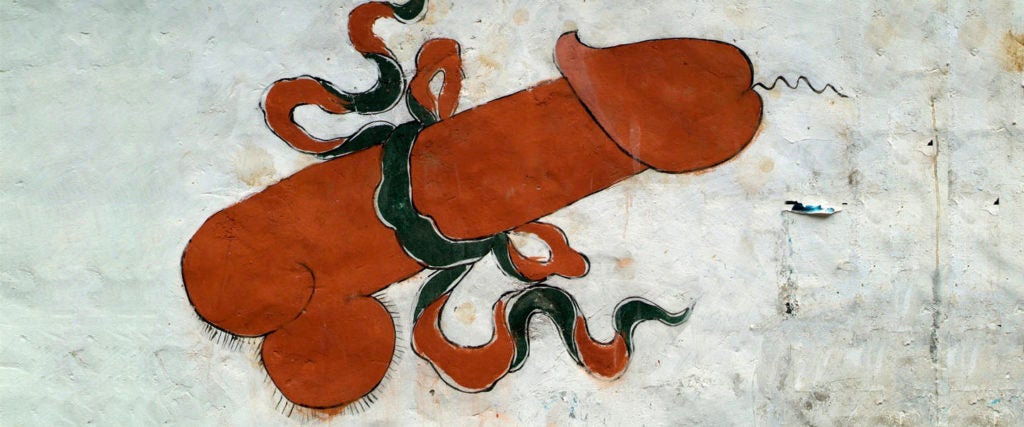Walk just about anywhere in Bhutan — the small South Asian country wedged between China and India on the edge of the Himalayas — and you’ll likely find large, ejaculating penises with hairy balls. They’re painted on the exterior walls of buildings, perched on the roofs of houses and fixed in front of doors to ward off bad luck.

The phallus is meant to demonstrate the virility of Bhutanese men and keep malicious gossip at bay, explains Sonam Dorji, a tour guide and senior reporter with News of Bhutan. “We believe phalluses dispel evil spirits,” he tells me, explaining Bhutanese people to be especially superstitious. “Even when we play games like archery and khuru [darts], if a player fails to hit the target for a day, he will hang a phallus from the side of his waist to bring good luck.”
Dorji, too, had dicks protruding from his childhood home. His father crafted them from wood every year to replace old ones on four corners of their roof. “Even our ladder had a phallus,” he explains.
Likewise, new homeowners in Bhutan hire men and women to participate in a housewarming ceremony in which a basket of wooden phalluses are raised to the roof by jovial men singing about the wonder of the penis, while women try to keep them from doing so. The men then mimic dropping the basket to the ground with hopes of scoring free booze from the homeowner so they’ll be energized to complete the task. Following the (free) drinks, the basket finally reaches the roof, where the phalluses are affixed.
Though the exact origin of the penis practice hasn’t been established, Bhutanese reverence of it began in the 15th century, when a Tibetan monk named Drukpa Kunley traveled to Bhutan to spread Buddhism. He’s also credited for amping up the country’s decorative phallus game, proclaiming his own penis to be a “Thunderbolt of Flaming Wisdom” capable of combating evil. (He allegedly vanquished a demon dog with it.) Followers viewed Kunley’s “penis temple,” Chimi Lhakhang, as an audacious gesture against the rigidity of other monasteries, pun very much intended.

Kunley was known as the “Divine Madman” for the way he taught people (mostly women) with dance, music, wine and sex at Chimi Lhakhang, believing it possible to be both enlightened and lead a healthy sex life. One of few Buddist teachers to appear exclusively topless in paintings, Kunley refused to bless anyone unless they brought a beautiful woman and a bottle of wine for his efforts, his particular method of healing being to touch his “thunderbolt” to the heads of visitors.
Curious wanderers and couples hoping to conceive still make the pilgrimage to Chimi Lhakhang’s notorious monastery, where women seeking fertility blessings are hit on the head with a 10-inch ivory phallus by the presiding lama. Often, the blessing will include a prediction of the hypothetical baby’s name and gender, revealed in bamboo slips inscribed with names on the altar.
Five hundred years later, phalluses are no longer relegated to Kunley’s temple, but they’re also not quite as ubiquitous as they used to be. “Educated people in the younger generation have reservations about the phallus,” Dorji explains, “but you will surely still see buildings painted with them in the city. I think that’s why we have such good luck here.”

